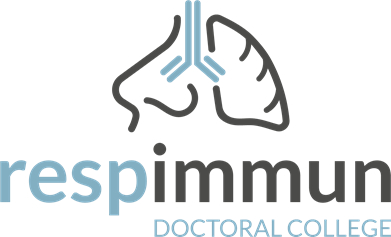
respimmun.at
• Böhm
• Heinemann
• Höfler
• Kargl
Kwapiszewska ⏩
• Leithner
• Marsche
• Marsh
•Moissl-Eichinger
• Olschewski A
• Strobl
• Heinemann
• Höfler
• Kargl
Kwapiszewska ⏩
• Leithner
• Marsche
• Marsh
•
• Olschewski A
• Strobl


The RESPImmun Faculty

|
Grażyna KWAPISZEWSKA, PhDInterplay between inflammatory cells and basement membrane components in the development of pulmonary hypertension due to chronic lung diseases |
|
Otto Loewi Research Center, Division of Physiology; Medical University of Graz, Neue Stiftingstalstraße 6/VI;
Ludwig Boltzmann Institute for Lung Vascular Rearch, Medical University of Graz, Neue Stiftingtalstraße 6/VI, A-8010 Graz; | |
| websites: [RESPImmun] [LBG] | |
| • Profile ⏬ • Curriculum vitae • PhD students • Grants • Publications | |
Grażyna Kwapiszewska is a molecular biologist who focuses her research on mechanisms regulating lung and vascular remodeling. Recently, she ihas dentified that specialized extracellular matrix, basal membrane differs in diverse forms of PH and that degradation products of basal membrane (matrikines) might serve as biomarkers. Currently she is investigating the effects of inflammatory cells and their mediators in vascular remodeling processes. Within RESPImmun, she closely collaborates with Á Heinemann and Herbert Strobl (inflammatory cells), Leiht Marsh (animal models), Horst Olschewski (patient samples), Gerald Höfler (pathology) and Andrea Olschewski (inflammatory mediators).
Project
Project 8: Interplay between inflammatory cells and basement membrane components in the development of pulmonary hypertension due to chronic lung diseasesCo-PI: Gábor Kovács
Background
Chronic obstructive pulmonary disease (COPD) and idiopathic pulmonary fibrosis (IPF) are chronic and progressive lung diseases that lead to a decrease in lung function. Both chronic lung diseases (CLD) can be complicated by pulmonary hypertension (PH), which worsens patient survival. Remodelling of the small pulmonary arteries is the key pathologic hallmark of PH in both COPD and IPF, albeit to different degrees. Basement membrane (BM) is integrative part of the vessel wall and is produced by endothelial (EC) as well as pulmonary arterial smooth muscle cells (PASMC). Disturbance of BM can lead to the influx of inflammatory cells. Previously we have shown that BM components are dysregulated in the vessel wall of patients suffering from idiopathic pulmonary arterial hypertension and that BM components actively influence the function of EC. BM degradation products, matrikines, can lead to EC apoptosis and serve as prognostic markers. The major source of the enzymes such as MMPs and cathepsins leading to matrikine release are inflammatory cells. Additionally, matrikins can actively modulate the inflammatory landscape and further potentiate the disease development.Hypothesis and objectives
Our recent data provide evidence that (1) BM expression is dysregulated in PH, (2) inflammatory cells could be a potential source of enzymes leading to release of matrikines, (3) CLDs possess distinct inflammatory profiles in remodelled vessels. Therefore, against this background we hypothesize that BM composition differs between diverse forms of PH due to the CLD. We also hypothesize that certain inflammatory cell subpopulations are the source of enzymes liberating matrikines, which in turn modulate EC and SMC behaviour facilitating vascular remodelling in PH-CLD. Thus, matrikines can actively lead to PH-CLD development and progression.Methodology
In this project the student will: (i) assess the expression and composition of BM in PH-CLDs, (ii) determine the inflammatory cells being the source of enzymes releasing matrikines from BM, (iii) delineate the role of BM/matrikines on both EC and PASMC and its downstream signalling, (iv) investigate the role of matrikines on inflammatory cell recruitment. In the 1st and 2nd year: BM and liberating enzymes: MMPs and cathepsins will be quantified by qPCR and localisation determined by multicolour-confocal fluorescence microscopy. The specific inflammatory cells will be isolated and co-culture with EC and PASMC will be conducted to investigate the levels of matrikines in the supernatant. In the 3rd year: Functional responses of BM/matrikines on EC and PASMC will be investigated by migration, proliferation and electric cell-substrate impedance sensing. Downstream signaling will be assessed by transcriptomic analysis and by chip-based technology (PamChip) in combination with the PamStation12 instrument (PamGene) to assess real-time activity measurement of multiple tyrosine or serine / threonine kinases in a single sample. In the 4th year: The student will analyse the effects of matrikines on inflammatory landscape. Chemoattractant activities will be measured. The effects of matrikines on lung function, haemodynamics and morphological analysis will be analysed in in vivo models.Input from collaborations within the RESPImmun programme
- Ákos Heinemann and Herbert Strobl will support the project with inflammatory cells isolation,
- Horst Olschewski will provide blood and plasma samples,
- Leigh Marsh will train the student in experimental mouse models of CLD and provide expertise in the characterization of inflammatory cells,
- Gerald Höfler will support the student with his expertise on lung pathology,
- Andrea Olschewski with effects of mediators on EC employing live-cell calcium imaging.